How To Use A Tortilla Press? Here Is A Step-by-Step Guide To Start!
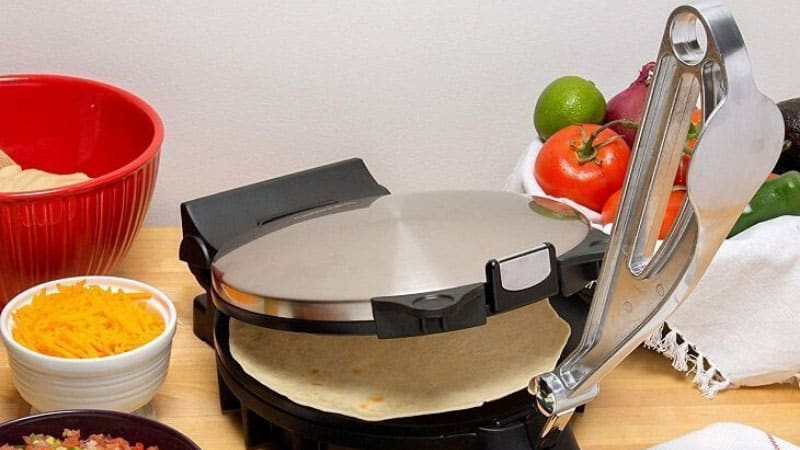
There’s nothing like a fresh tortilla prepared from scratch! Even though I now own a tortilla press, I recollect all of my previous inquiries. I was apprehensive about making handmade tortillas, so I learned how to use a tortilla press step by step.
What you need to know is as follows:
A tortilla press consists of two hinged flat metal discs made of cast iron, wood, or aluminum. The top disc has a handle and presses down on the dough ball in the center to flatten it. To ensure that the raw tortilla can be readily taken off the press, place two sheets of plastic on opposite sides of the dough ball.
Almost every brand of store-bought tortillas can’t compare to the scent (especially when cooked on a Comal) and taste of homemade tortillas. However, there are many other questions about homemade tortillas and tortilla presses, so keep reading!
What is the purpose of a tortilla press?
A tortilla press, as previously said, is a mainstay in Mexican cuisine and would undoubtedly be found in any Mexican home. It’s commonly composed of cast iron or aluminum and features two flat, spherical surfaces with a diameter of around 8 inches. You lay new tortilla dough balls in the center and press down to flatten them.
Tortilla presses are available at your local Mexican market, larger supermarkets, and, of course, on Amazon.
What is the best way to keep tortillas from sticking to the press?
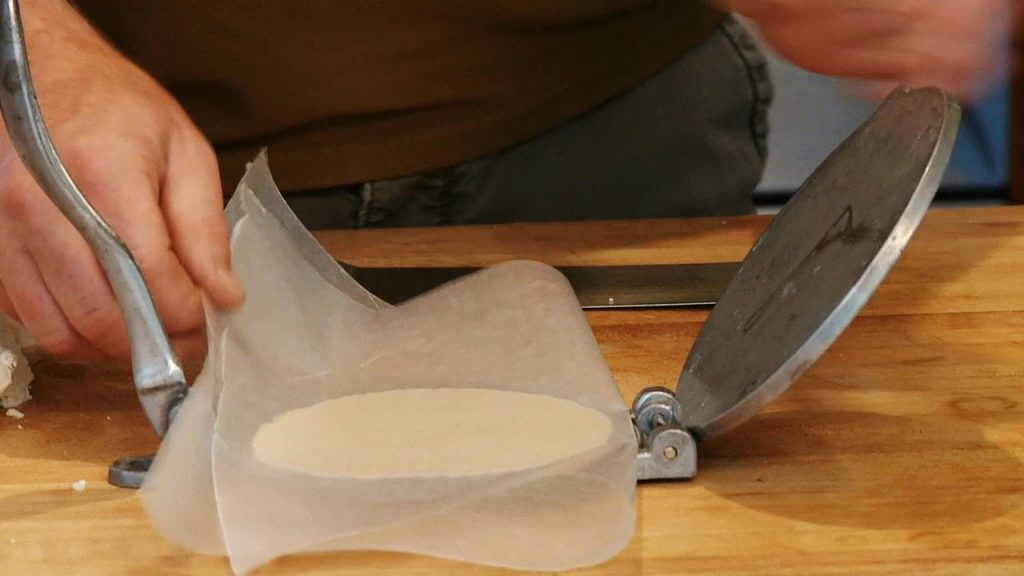
If you’re preparing fresh corn tortillas, a sheet of plastic or wax paper should be placed on both sides of the dough ball to prevent it from adhering to the press. Without the plastic, peeling off the dough will be extremely difficult. It will be nearly impossible to keep the tortilla shape intact.
Flour tortillas are more forgiving and can be made without plastic wrap. I believe that, regardless of the type of project, it is simpler to utilize plastic.
It also makes it much easy to clean the tortilla press.
Without a tortilla press, how do you press tortillas?
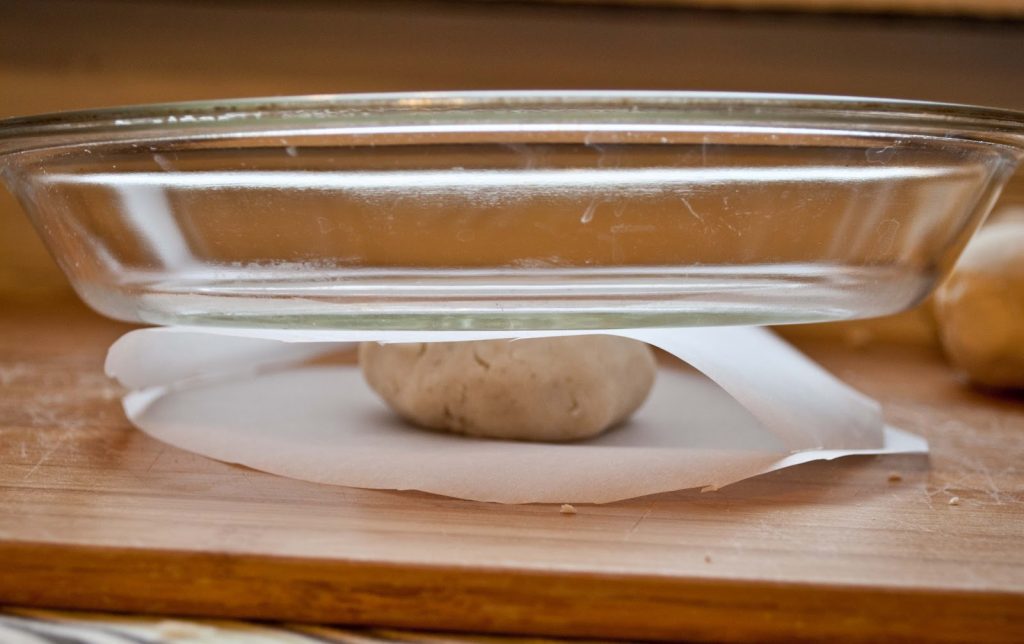
What, there’s no tortilla press? No trouble at all!
There are a few alternatives to using a mechanical press to press tortillas. The simplest method is to use two cutting boards. Put one on the counter and cover it with plastic wrap. Then set your dough ball in the center and cover it with a plastic sheet.
You can change the thickness of the tortilla by pressing harder for a thinner tortilla. Set a second cutting board on top and press down evenly, softly, and gradually. Remove the top cutting board and lift the plastic wrap gently to complete the process.
Another option is to use a rolling pin or a large, non-tapering glass.
I find this method more complicated, mainly when using corn tortillas. On the counter or chopping board, place a sheet of plastic wrap. Place your own ball in the middle and cover with a second layer of plastic.
Gently press down with the palm of your hand to flatten it down a little. Then roll and flatten uniformly with the rolling pin until your tortillas are thin enough (approximately 1/8 of an inch).
What’s the best way to create tortilla dough?
Tortillas can be made from nearly any dough.
Corn and flour, on the other hand, are the most frequent. However, you can use whole wheat flour or other gluten-free flour for a healthier option (corn is naturally gluten-free, though).
What is the best way to make flour tortillas?
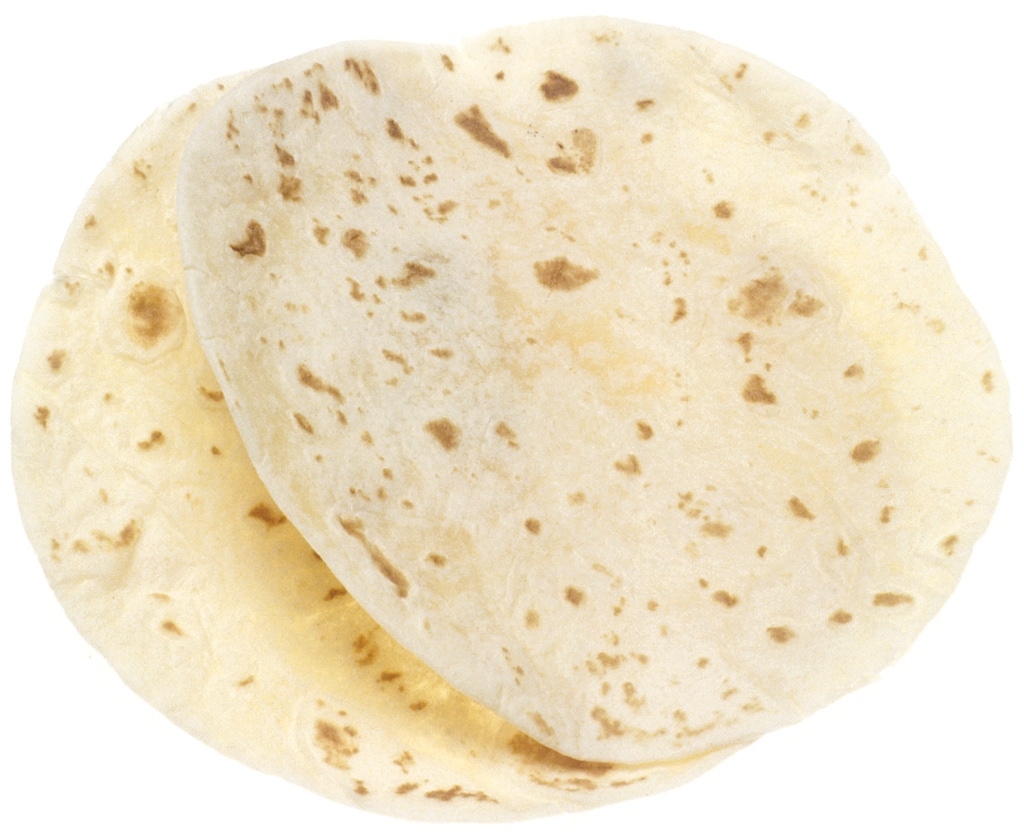
Aside from the taste, the advantage of making your own tortillas is that you have complete control over the components. Many store-bought flour tortillas contain hydrogenated oil (molecularly similar to plastic) as well as an aluminum-based baking powder (related to Alzheimer’s).
Only four ingredients are required for an excellent flour tortilla:
- Flour is a type of flour that is used (unbleached all-purpose) 2 cups –
- 1/2 teaspoon salt three tablespoons softened fat (oil, butter, lard, non-hydrogenated shortening)
- 3/4 cup water (not cold)
- This recipe yields eight tortillas.
To begin, place everything in a food processor except the water (blade is fine). If you’re using oil instead of solid fat, leave it out of the recipe and mix it with the water in a measuring cup.
Begin pulsing as you sprinkle in the water (or oil, if you’re using that as your fat).
Once all ingredients are in the processor, please turn it on low and blend until a ball forms naturally. Remove the ball and place it on a flour-dusted worktop or cutting board.
Knead the flour for a few minutes (pressing, rolling, and gently pulling), then roll it back into a ball and place it on a cutting board covered with a kitchen towel.
They’ll be ready to cook in 15 minutes.
Don’t skip the kneading and resting stages. Kneading and resting the gluten proteins align them, allowing you to press them without constricting or ripping.
Cut your large ball into eight pieces and roll each into a ball.
In corn tortillas, what is masa?
Live near a traditional Mexican market. You might be able to get ready-made corn tortilla dough and go straight to the rolling and cooking. However, the majority of us purchase a bag of Masa Harina maize flour, which can be found in practically every grocery store.
Dried maize is steeped in lime (calcium hydroxide, not lime juice) to prepare the dough and then crushed.
The dough is then dehydrated and ground into flour, also known as Masa Harina. Then all we have to do is add water to make it into the dough again.
Corn Tortillas: How to Make Them
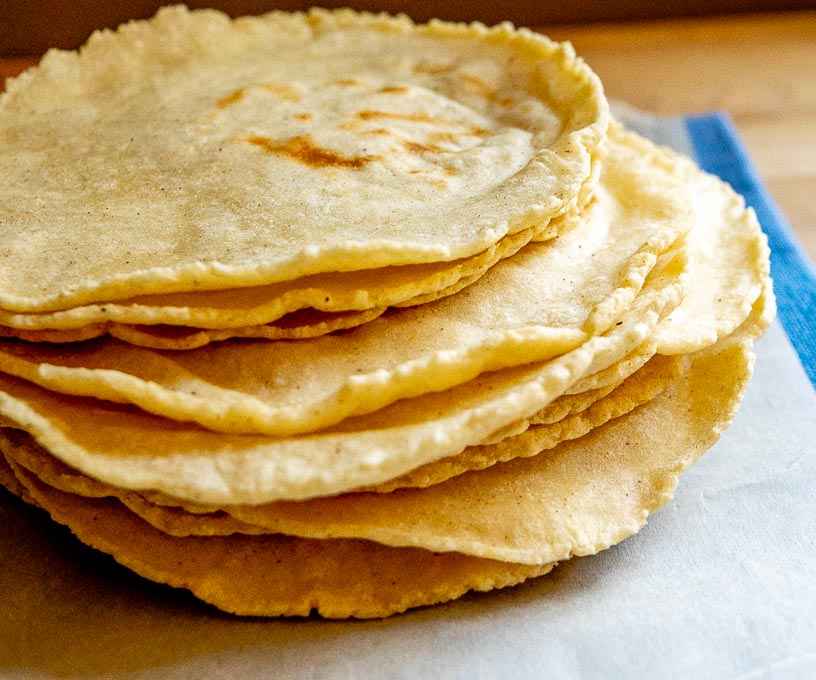
Fresh, handcrafted corn tortillas, as I previously stated, are truly unrivaled. You’ll never repurchase store-bought ones once you’ve mastered them, and you’ll be tempted to stop using flour as well.
To create corn tortillas, all you need is:
- 2 cups masa harina
- A half teaspoon of salt
- 1.5 quarts hot water
In a food processor, combine the dry ingredients and gradually pulse in 1 cup of water, just as you did with the flour tortillas. It’ll resemble tiny pellets.
Then continue pulsing as you add the remaining water.
After all of the water has been added, pick it up and knead it. Is it too sticky? More masa harina should be added. Is it too crumbly? More water should be added. Make a single large ball with the mixture. Then divide into approximately eight pieces and roll each into a golf ball-sized ball.
Now it’s time to fry and flatten. No resting period is required, unlike with flour (no gluten).
What is a tortilla press, and how do you use it?
We’re now ready to utilize a tortilla press to press our tortillas, as I mentioned above, for the sake of maintaining the stages in sequence. For wheat tortillas, plastic sheets are optional, but for corn tortillas, they are required. In either case, I prefer to use plastic.
Women frequently use plastic grocery sacks in Mexico’s local markets. Still, I wouldn’t recommend it because we don’t know where they’ve been or what’s been in them. I also wouldn’t use cling wrap because it’s sticky and difficult to deal with. Ziplock bags or wax paper can also be used.
Cut freezer or gallon-sized bags in half to make zip-lock bags. Then, on the bottom plate of the press, insert one piece of plastic and a dough ball on top. Then add the second layer of plastic on top.
You should get a nice, round tortilla if you press down gently and carefully on your tortilla press. They can split apart if you press too hard and too fast.
What do you use to make tortillas?
Tortillas, whether corn or flour, were traditionally cooked on a Comal. A Comal is a flat disc commonly formed of clay, but cast-iron Comal are more common in the United States. On the other hand, the cast-iron ones usually come with a handle.
Comal’s, unlike skillets, don’t have much of a side lip; thus, there’s no point at which they start to bend up. They only have a sliver of a lip.
What, no Comal? It’s not an issue.
It’s pretty OK to use a large skillet or griddle for this. There are a few gimmicks here. First and foremost, do not overheat the Comal or skillet.
If you cook them too hot, they will burn before they are thoroughly done.
Unless you’re just warming up store-bought tortillas, the other technique is to cook one at a time. You can spread them out and fry a couple at a time if you have a large griddle, but don’t stack raw tortillas to cook them.
What’s the best way to prepare tortillas?
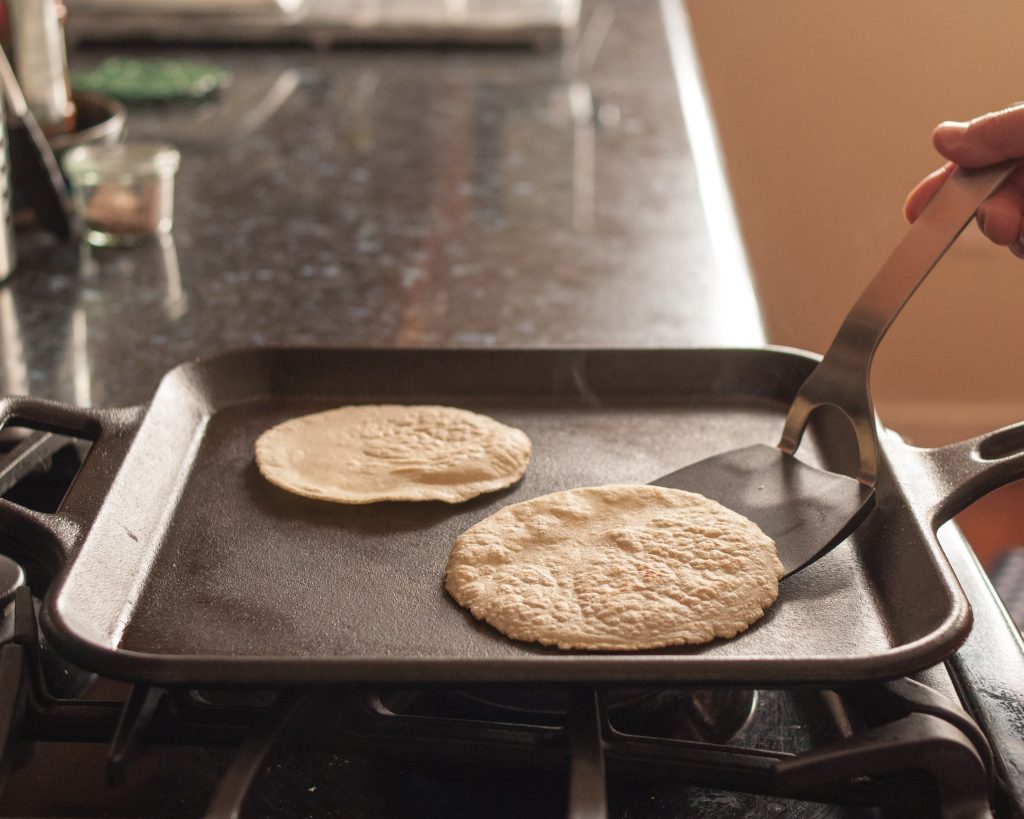
I like to remove the plastic wrap off the bottom of the tortillas and then delicately peel away the top covering while holding the tortilla disc in one hand and setting it down on the hot surface. You won’t want to move the raw tortilla dough for at least 30 seconds once it meets the hot Comal or griddle, so make sure to place it precisely flat on your first try (which has a slight learning curve).
Allow around 30-45 seconds for the tortilla to cook before flipping.
Cook for another 30 seconds on the other side. While you can flip the chicken back and forth, if you’ve nailed the timing and temperature, you’ll only need to cook each side once.
It’s okay if they puff up a little, and the color should begin to darken. On the other hand, large black blotches are not desirable (that means the Comal is too hot or you left it on the surface too long).
Transfer to a cloth-covered basin with a lid once they’ve reached a lovely dark tan color to keep them warm. Regardless of how affordable they are, if you’re serious about Mexican and Latin cooking, I strongly advise you to invest in a Comal.
What’s the best way to keep corn tortillas from tearing?
Use extreme caution when flattening fresh, uncooked maize tortillas. Keep the disc sandwiched between the plastic sheets until ready to cook.
If they split or rip as you roll them out, the tortilla dough was probably too dry.
Whether corn or flour, Tortilla dough is primarily a combination of flour, water, and, in the case of flour, fat (could be oil, lard, butter, etc.).
If you add too much water, they will become overly runny. They’ll be too dry if you use too much flour. They’ll be too sticky if there’s too much fat in them.
I’ve included the best recipes below to ensure that your blend is flawless.
Are you able to roll corn tortillas?
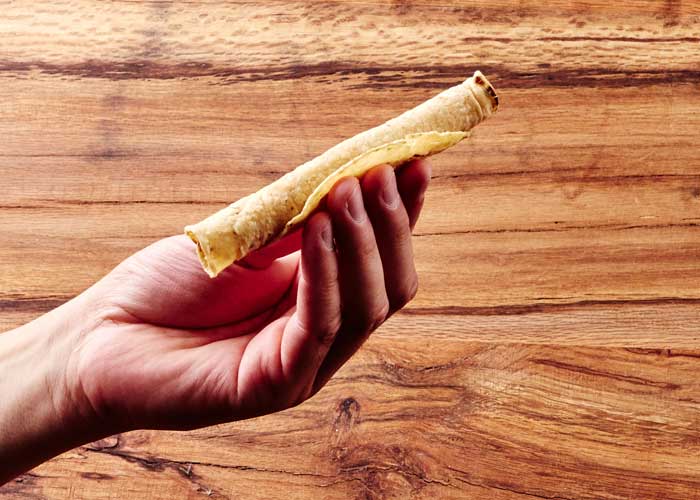
The quick answer is yes; otherwise, there would be no enchilada.
On the other hand, store-bought maize tortillas can be tough to roll without splitting or cracking.
In Mexico, frying maize tortillas in oil is customary to soften them.
I use a skillet with a bit of oil in it. Heat the oil to medium-high and dip the tortilla in for a few seconds once it’s hot. Depending on the depth of your oil, you may want to flip the tortilla with tongs or delicately press it down with a wooden spoon.
Then take it out and drain it on a paper towel-lined dish.
If you leave the tortillas in the oil for too long, they will become crunchy tortilla chips (not a bad thing, but not what you want for enchiladas). However, use them while they’re still hot, since the longer they sit, the more challenging they’ll get. After frying the enchiladas, they were customarily dipped in hot enchilada sauce to cover them.
After that, you’d stuff and roll.
How can corn tortillas be softened without being fried?
Many people watching their weight want to know how to soften tortillas without frying them, as I describe above. While frying is the most effective approach, there are also other options. By wrapping a stack of tortillas in a clean kitchen towel and setting them in a steamer dish in a pot of boiling water, you can soften them. Ensure there isn’t enough water in the pan to cover the tortillas.
When steaming, less is more since it adds water, and too much water causes tortillas to come apart. Alternatively, you may microwave a stack wrapped in a damp (but not soaked) towel for 1 minute. After 30 seconds, have a look at them and rotate which ones are on top and bottom.
Are our flour tortillas preferable to corn tortillas?
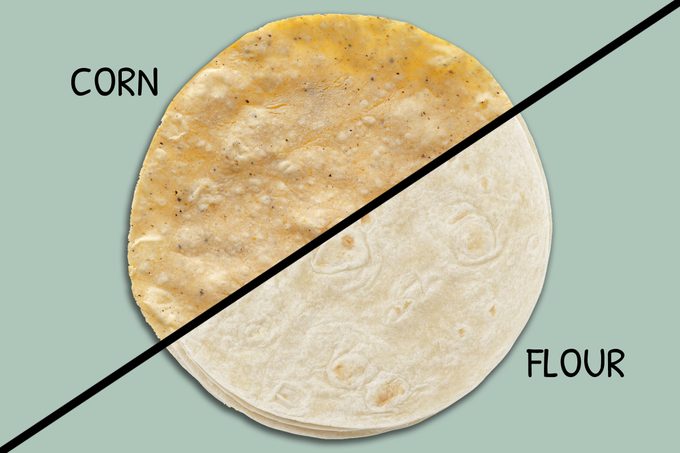
The million-dollar question is this.
It’s also subjective and a question of personal preference. On the other hand, Corn tortillas were here first, predating the Spanish conquest of Mexico. Corn tortillas may be traced all the way back to the Mayans and Aztecs.
When it comes to store-bought tortillas, flour tortillas are unquestionably superior. Corn tortillas purchased at the store are tough and leathery. They’re easy to crack and break, and they’re chewy and flavorless.
On the other hand, flour tortillas stay soft and malleable when rolled and don’t split.
Fresh corn tortillas, on the other hand, are very delicious!
You haven’t eaten corn tortillas until you’ve experienced fresh-made corn tortillas. Once you’ve tried a fresh corn tortilla, you’ll agree with me that it’s the best tortilla out there.
What is the best tortilla press?
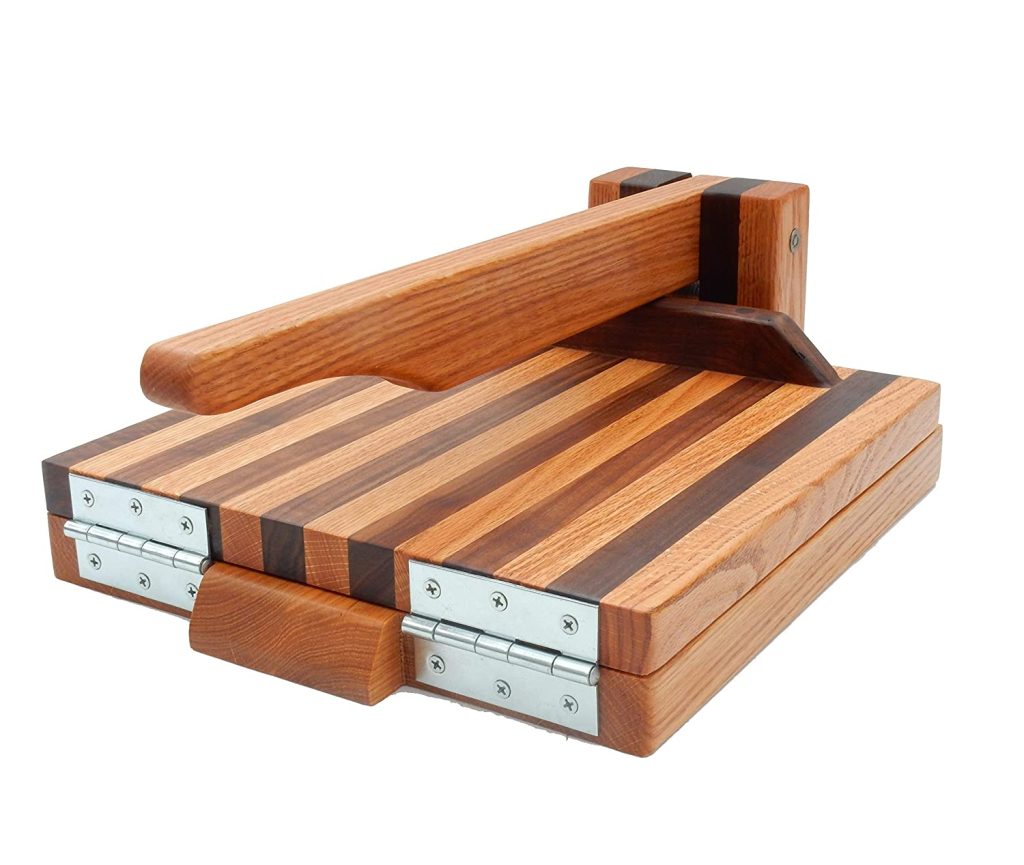
Cast iron, wood, aluminum, and even electric ones that cook as they flatten are all available.
I prefer the old-fashioned cast-iron versions.
Mine is silver, and while I don’t want the paint to come into contact with my food because I use plastic sheets to encase the dough totally, it doesn’t matter.
You want something hinged and flattens nicely when you press down on the handle. You’ll wind up with a thick cake if the cake isn’t flat enough (which has its uses). It won’t retain your filling without tearing if it’s too thin.
I searched Amazon and only looked at things with 4.5 stars.
Then I eliminated those with fewer than 100 reviews. Then I went a step further and deleted any that had more than 3% of the reviews being 1 star.
After that, I had a definite winner on my hands.
Nothing could compare to Central Coast Woodworks’ Hardwood Tortilla Press. Solid walnut and wood, coated with food-grade mineral oil and beeswax. It’s as attractive as it is functional. There’s also free shipping.
Have I answered all of your questions regarding operating a tortilla press?
I took you on a tour of the world of fresh, handcrafted tortillas in this post.
Nothing compares to the taste of a freshly baked tortilla. Homemade tortillas are far superior to store-bought tortillas, whether you want corn, flour, whole wheat, or even gluten-free alternatives (corn is already gluten-free).
The tortilla press is essential for producing them at home, so I wrote this essay to remove the mystery and dread of learning how to operate one.











